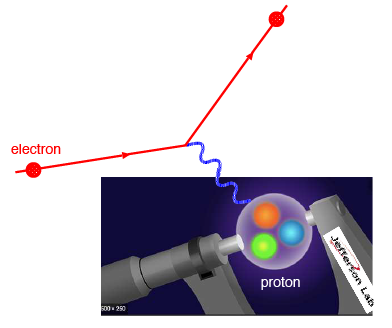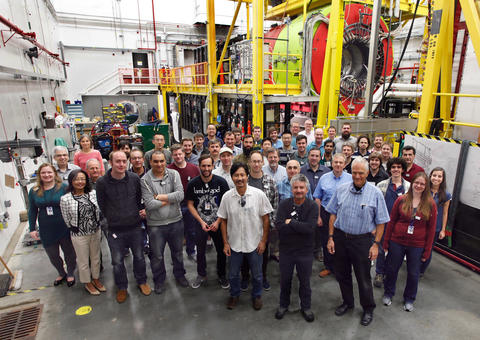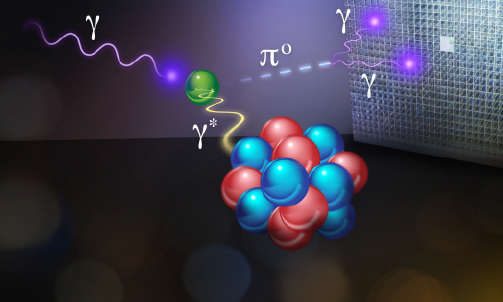Nuclear Physics
The nuclear physics group performs experimental research in collaboration with many university research groups conducted at the Jefferson Laboratory (JLab), a world-class high energy nuclear physics facility under the Department of Energy (DOE). Our group is playing leadership roles in several experimental projects at JLab: (a) precision determination of the proton radius; (b) high precision measurements of the light elementary particles (pseudoscalar mesons) to address the fundamental symmetries and their breaking phenomena in physics. Our group is also a part of the low-energy nuclear physics research program with Triangle Universities Nuclear Laboratory (TUNL) at Duke University.
Faculty
Abdellah Ahmidouch (Professor) research interests are in Intermediate and Low Energy Nuclear Physics; Nuclear Nonproliferation and Nuclear Special Materials, Physics and STEM Education, Development of Nuclear and Particle Physics Instrumentation, Medical Physics, and Nuclear Energy.
Ashot Gasparian (Professor) research interests are the area of intermediate energy nuclear and particle physics, precision measurements, Monte Carlo simulations, development of nuclear and particle physics instrumentation, and detection systems.
Former Members
Ronald Pedroni (Associate Professor) conducts research in intermediate energy nuclear and particle physics.
Research Projects
High Precision Measurement of the Proton Radius (PRad experiment at Jefferson Laboratory).
 The size of the proton, also known as its charge radius, is an important fundamental quantity in physics. The precise knowledge of this quantity has a wide variety of impact ranging from the understanding of the strong force that holds atomic nuclei together to our knowledge of fundamental constants of nature, like the Rydberg constant. For nearly half a century the radius of the proton had been obtained from measurements of the energy levels of the hydrogen atom or by scattering electrons from hydrogen atoms. In 2010 the proton charge radius was obtained for the first time by precisely measuring the energy levels of an exotic kind of hydrogen atom showing about 4.5% smaller radius than all previous modern measurements. This was called the “proton charge radius puzzle” in atomic and nuclear physics. The PRad collaboration at JLab lead by Dr. A. Gasparian, during the last few years performed a new high precision experiment with a novel method showing agreement with the smaller proton radius. The results were published in the Nature journal (Nature 575, 145 – 150 (2019)). The result of our experiment helped to assign a new value on the proton charge radius by the international data compilation organizations like the “Particle Data Group” and “CODATA”. The PRad collaboration is currently preparing a new experiment to improve the proton radius measurement by a factor of two-and-half.
The size of the proton, also known as its charge radius, is an important fundamental quantity in physics. The precise knowledge of this quantity has a wide variety of impact ranging from the understanding of the strong force that holds atomic nuclei together to our knowledge of fundamental constants of nature, like the Rydberg constant. For nearly half a century the radius of the proton had been obtained from measurements of the energy levels of the hydrogen atom or by scattering electrons from hydrogen atoms. In 2010 the proton charge radius was obtained for the first time by precisely measuring the energy levels of an exotic kind of hydrogen atom showing about 4.5% smaller radius than all previous modern measurements. This was called the “proton charge radius puzzle” in atomic and nuclear physics. The PRad collaboration at JLab lead by Dr. A. Gasparian, during the last few years performed a new high precision experiment with a novel method showing agreement with the smaller proton radius. The results were published in the Nature journal (Nature 575, 145 – 150 (2019)). The result of our experiment helped to assign a new value on the proton charge radius by the international data compilation organizations like the “Particle Data Group” and “CODATA”. The PRad collaboration is currently preparing a new experiment to improve the proton radius measurement by a factor of two-and-half.
Lead by Dr. A. Gasparian (agaspari@ncat.edu)
Relevant Publication:
- Xiong, W., Gasparian, A., Gao, H., Pedroni, R., ... & Gnanvo, K. (2019). A small proton charge radius from an electron–proton scattering experiment. Nature, 575(7781), 147-150.
Precision Measurement of the Neutral Pion Lifetime (PrImEx experiment at Jefferson Laboratory)
 Symmetries play critical roles in the development of fundamental theories in physics. They are equally important in understanding the basic properties of elementary particles. In contemporary physics, it is proven that not only the symmetries but also their partial breaking phenomena are critically important in physical processes occurring in Nature. The symmetry-breaking processes result from a pure quantum mechanical phenomenon: the quantum fluctuations or perturbations of the fundamental interactions between physical objects (fields). These fluctuations, in turn, are direct consequences of the celebrated uncertainty principle in quantum physics, which is not present in the classical description of Nature. In particular, two fundamental symmetries are directly involved in the existence and the lifetime of the neutral pion (π0): the axial and left-right chiral symmetries. The PRimEx collaboration at JLab lead by Dr. A. Gasparian developed and performed two modern experiments to measure the neutral pion lifetime with an unprecedented 1.5% precision. The results of these experiments are published recently in the Science journal (Science, vol. 368, issue 6490, pp. 506-509, May 2020). The PrimEx result provides a critical input for the normalization of the neutral pion transition form factor, which is needed for hadronic light-by-light scattering contributions to the well-known muon (g-2) anomaly, search for physics beyond the standard model.
Symmetries play critical roles in the development of fundamental theories in physics. They are equally important in understanding the basic properties of elementary particles. In contemporary physics, it is proven that not only the symmetries but also their partial breaking phenomena are critically important in physical processes occurring in Nature. The symmetry-breaking processes result from a pure quantum mechanical phenomenon: the quantum fluctuations or perturbations of the fundamental interactions between physical objects (fields). These fluctuations, in turn, are direct consequences of the celebrated uncertainty principle in quantum physics, which is not present in the classical description of Nature. In particular, two fundamental symmetries are directly involved in the existence and the lifetime of the neutral pion (π0): the axial and left-right chiral symmetries. The PRimEx collaboration at JLab lead by Dr. A. Gasparian developed and performed two modern experiments to measure the neutral pion lifetime with an unprecedented 1.5% precision. The results of these experiments are published recently in the Science journal (Science, vol. 368, issue 6490, pp. 506-509, May 2020). The PrimEx result provides a critical input for the normalization of the neutral pion transition form factor, which is needed for hadronic light-by-light scattering contributions to the well-known muon (g-2) anomaly, search for physics beyond the standard model.
Relevant Publication
- Larin, I., Zhang, Y., Gasparian, A., Gan, L., ..., Danagoulian, S., ... Ahmidouch, A., ... Pedroni, R., ... et al. (2020). Precision measurement of the neutral pion lifetime. Science, 368(6490), 506-509.
Contact Dr. A. Gasparian (agaspari@ncat.edu)
Precision Measurement of Eta-meson Radiative Decay Width, the Lifetime (PrimEx-D collaboration at Jefferson Laboratory)

Labs and Facilities
Our experimental research in experimental nuclear physics is being conducted at the Thomas Jefferson National Accelerator Facility (TJNAF), also known as Jefferson laboratory (JLab), under the Department of Energy (DOE).
The website: www.jlab.org
Collaborations
- PRad collaboration at Jefferson Lab.
- PrimEx collaboration at Jefferson Lab.
- GlueX/PrimEx-D collaboration at Jefferson Lab.
Research Opportunities
-
Undergraduate
Undergraduate research support is available for one student research including a stipend for research training.
Contact Dr. A. Gasparian (agaspari@ncat.edu)
-
Graduate
Graduate research support is available for one student research including tuition (in-state) and research assistantship.
Contact Dr. A. Gasparian (agaspari@ncat.edu)
-
Post-Doctoral
Contact Dr. A. Gasparian (agaspari@ncat.edu)



